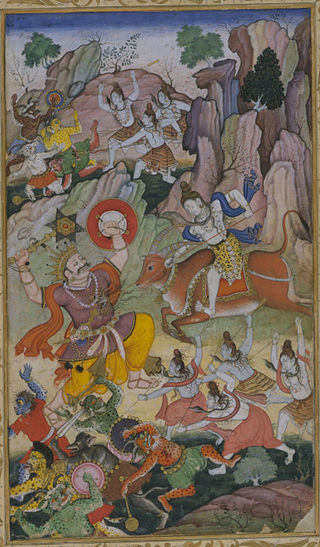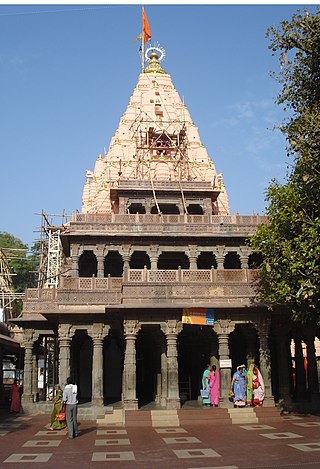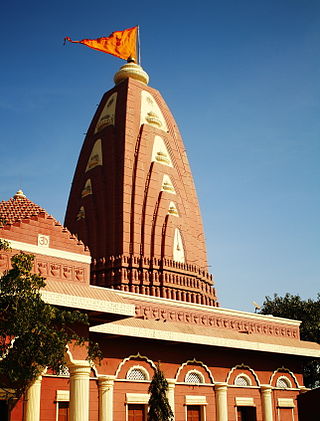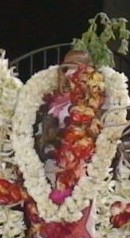
Parvati, also known as Uma and Gauri, is one of the principal goddesses in Hinduism, revered as the goddess of power, energy, nourishment, harmony, love, beauty, devotion, and motherhood. Along with Lakshmi and Sarasvati, she forms the trinity, known as the Tridevi.

In Hindu literature, Andhaka refers to a malevolent asura, whose pride is vanquished by Shiva and Parvati.

The Elephanta Caves are a collection of cave temples predominantly dedicated to the Hindu god Shiva, which have been designated a UNESCO World Heritage Site. They are on Elephanta Island, or Gharapuri, in Mumbai Harbour, 10 kilometres (6.2 mi) east of Mumbai in the Indian state of Mahārāshtra. The island, about 2 kilometres (1.2 mi) west of the Jawaharlal Nehru Port, consists of five Hindu caves, a few Buddhist stupa mounds that date back to the 2nd century BCE, and two Buddhist caves with water tanks.

Natha, also called Nath, are a Shaiva sub-tradition within Hinduism in India and Nepal. A medieval movement, it combined ideas from Buddhism, Shaivism and Yoga traditions of the Indian subcontinent. The Naths have been a confederation of devotees who consider Shiva as their first lord or guru, with varying lists of additional gurus. Of these, the 9th or 10th century Matsyendranatha and the ideas and organization mainly developed by Gorakhnath are particularly important. Gorakhnath is considered the originator of the Nath Panth.

Ramcharitmanas, is an epic poem in the Awadhi language, composed by the 16th-century Indian bhakti poet Tulsidas. It has many inspirations, the primary being the Ramayana of Valmiki.
Jalandhara, also known as Chalantarana is an asura in Hinduism. He was born when Shiva opened his third eye in his fury when Indra struck him with his thunderbolt. However, Indra was saved, and the energy emitted from the eye was sent into the ocean. The energy developed into a boy and was raised by Varuna, and eventually, by Shukra. When he grew up, he conquered the three worlds - Svarga (heaven), Bhuloka (earth), and Patala (underworld). He married Vrinda, the daughter of Kalanemi. He would be slain by his creator, Shiva.

Omkareshwar Temple is a Hindu temple dedicated to Shiva, located in Mandhata, nearby Khandwa city in Khandwa district of the Indian state of Madhya Pradesh. It is one of the 12 revered Jyotirlinga shrines of Shiva. It is on an island called Mandhata, near Khandwa city in the Narmada River at Khandwa district in Madhya Pradesh, India; the shape of the island is said to be like the Devanagari ॐ symbol.

Mahakaleshwar Jyotirlinga is a Hindu temple dedicated to Shiva and is one of the twelve Jyotirlingas, shrines which are said to be the most sacred abodes of Shiva. It is located in the ancient city of Ujjain in the state of Madhya Pradesh, India. The temple is situated on the side of the holy river Shipra. The presiding deity, Shiva in the lingam form is believed to be Swayambhu, deriving currents of power (Shakti) from within itself as against the other images and lingams that are ritually established and invested with mantra-shakti.

Sati, also known as Dakshayani, is the Hindu goddess of marital felicity and longevity, and is worshipped as an aspect of the mother goddess Shakti. Sati was the first wife of Shiva, the other being Parvati, who was Sati's reincarnation after her death.

Gangaur is a Hindu festival celebrated in the Indian states of Rajasthan, Haryana, the regions of Malwa, Nimar regions of Madhya Pradesh and the Braj and Bundelkhand regions of Uttar Pradesh. It is also celebrated in some parts of Gujarat and West Bengal. A variation of same festival known as Chaitra Gauri Vrat is observed on the same day in the states of Maharashtra and northern Karnataka. Another variation called Saubhagya Gauri Vratam is observed in the states of Telangana and Andhra Pradesh.

Teej, literally meaning the "third" denoting the third day after the new moon when the monsoon begins as per the Hindu calendar, is a combined name for 3 Hindu festivals primarily dedicated to Hindu deities - the mother goddess Parvati and her male consort Shiva, mainly celebrated by married women and unmarried girls mostly in Nepal and North India to wish for the long life of their husband or future husband and to welcome the arrival of monsoon season with the singing, swings, dancing, enjoyment, prayer rituals and often fasting.

There are many anecdotes of Ganesha. Ganesha's elephant head makes him easy to identify. He is worshipped as the lord of beginnings and as the lord of removing obstacles, the patron of arts and sciences, and the god of intellect and wisdom. Stories about the birth of Ganesha are found in the later Puranas, composed from about 600 CE onwards. References to Ganesha in the earlier Puranas, such as the Vayu and Brahmanda Puranas are considered to be later interpolations made during the 7th to 10th centuries.

Annapurna, Annapurneshwari, Annada or Annapoorna is a manifestation of Parvati and is known as the Hindu goddess of food and nourishment. Worship and offering of food are highly praised in Hinduism, and therefore, the goddess Annapurna is regarded as a popular deity. She is a manifestation of the goddess Parvati, the consort of Shiva, and is eulogized in the Annada Mangal, a narrative poem in Bengali by Bharatchandra Ray. The Annapurna Sahasranam is dedicated to the goddess and praises her one thousand names, while the Annapurna Shatanama Stotram is dedicated to her 108 names.

Nageshwar Temple is a Hindu temple dedicated to the Hindu god Shiva located on Dwarka, Gujarat, India. one of the legendary temples mentioned in the Shiva Purana and is one of the twelve Jyotirlingas. Nageshvara jyotirlinga is situated in a forest called Daarukavanam In Gujarat
Jaya Parvati Vrat or Gauri Vrat, is a Hindu festival observed in the month of Ashadha whereby unmarried women fast for five days and worship the Hindu goddess Parvati in order to seek an ideal husband. Foods containing salt are not eaten; instead, items such as wheat flour, milk, ghee and fruits are consumed. The festival is observed mainly in the state of Gujarat.

Sri Bhramaramba Mallikarjuna Temple or Srisailam Temple is a Hindu temple dedicated to the deities Shiva and Parvati, located at Srisailam in the Indian state of Andhra Pradesh. It is significant to the Hindu sects of both Shaivism and Shaktism as this temple is referred to as one of the twelve Jyotirlingas of Shiva and as one of the eighteen Shakti pithas, centres of the Hindu goddess. Shiva is worshiped as Mallikarjuna and is represented by the lingam. His consort Parvati is depicted as Bhramaramba.
Yogi Nath is a Shaivism-related group of monks which emerged around the 13th-century. They are sometimes called Jogi or simply Yogi, and are known for a variety of siddha yoga practices.

Ashokasundari is a Hindu goddess and daughter of deities Shiva and Parvati.

Tirunilakanta Nayanar, also known as Tirunilakanta, Nilakantan and Tirunilakantar (Thiruneelakandar) was a Nayanar saint, venerated in the Hindu sect of Shaivism. He is generally counted as the second in the list of 63 Nayanars.
Kānhaḍade Prabandha is a book by Indian poet Padmanābha written in 1455, in a western Apabhramsha dialect. The book tells the story of Raval Kanhadade (Kanhadadeva), the Chahamana ruler of Jalore.














